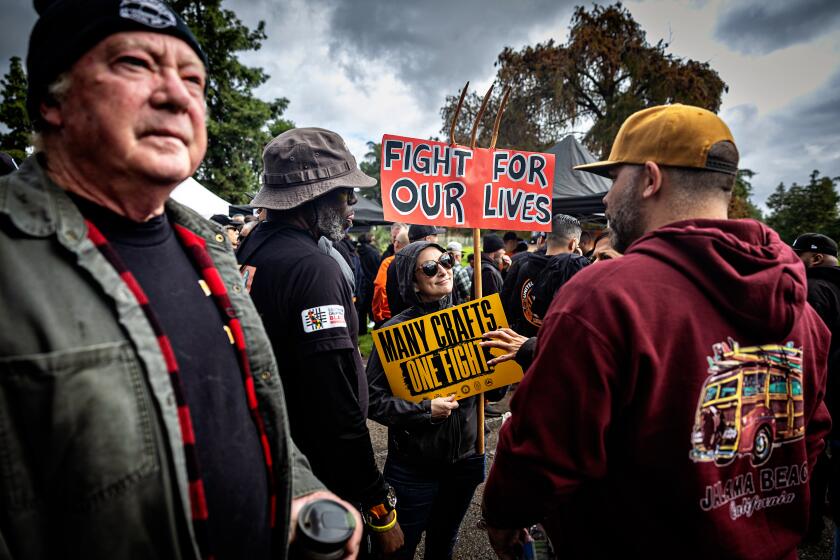Radio-Tagged Product Codes Get on the Fast Track
Backers of new radio-tagged product codes, a kind of souped-up wireless bar code, are heralding this as the week the technology finally moves off the drawing board and into the physical world.
Unlike traditional bar codes, radio frequency identification tags don’t need to pass under a laser reader. They already are commonly used by drivers with “speed passes” at toll booths, U.S. military quartermasters and ranchers tracking livestock from “farm to fork.”
But the MIT lab developing the technology and sponsors including Wal-Mart Stores Inc., Gillette Co. and Procter & Gamble Co. are calling a symposium this week in Chicago the beginning of the next step: embedding the chips in shipping crates to help big firms save billions by tracking their products from factory to warehouse to storeroom.
For now, the focus is on logistics: making sure there’s enough to fill the shelves but not so much as to clog up supply lines. Using the identification tags to track individual products all the way to the checkout line is further down the road, when costs come down.
“The symposium is intended to be a bit like a starting pistol for this new technology,” said Kevin Ashton, executive director of MIT’s Auto-ID Center. “It’s where we cross the line from research to reality.”
For some, however, the technology is moving a little too quickly.
It got a push -- some say a kick -- this summer when Wal-Mart told its top 100 suppliers to deliver radio frequency identification-tagged products by Jan. 1, 2005. With nearly $700 million in sales a day in 2002, Wal-Mart had the clout to give orders, and the announcement sent suppliers scrambling to respond.
Some, like Procter & Gamble, already were enthusiastically pursuing the technology on their own. But a new research report suggests others are feeling rushed to implement it.
They also are worried that if a common set of standards fails to emerge they’ll have to build a new system for each customer. And if standards do emerge, they worry they’ll be forced to share information with competitors when they plug into the systems of customers they share.
“With every supplier, there are two camps,” said Kara Romanow, an analyst with AMR Research, whose report estimated companies would spend $2 billion trying to meet the Wal-Mart deadline. “There’s the camp that believes the end vision and has really bought into the hype. Then there are the people that are charged with implementing it that are scared.”
Some privacy advocates, who contend the technology will soon be used to track people and their personal information, also are worried that the tracking technology is moving too fast. Katherine Albrecht of the privacy group Caspian said citizen and consumer advocates should have been invited to the Chicago symposium to discuss their concerns. Instead, her group now plans to protest.
“It’s such a one-sided conversation about the needs of businesses, with so little input from the citizens and consumers who are the major stakeholders in society,” she said.
Ashton, of the Auto-ID Center, said privacy advocates should be part of the debate, but he said that as the technology develops, rules will apply: Any customers who end up with the tracking technology in their hands will be notified, given the option of turning it off and given control over how any information is used.
The 1,000 attendees at the Electronic Product Code symposium probably will have questions about privacy as well as standards and the rush by the “Wal-Mart 100” to comply with the company’s mandate.
Bentonville, Ark.-based Wal-Mart has a long tradition of setting tough rules for its suppliers, but experts say this is the toughest directive yet, given the tight deadline and the novelty of the technology.
The order, and the presumption that other big retailers will follow suit, has sparked an industry of radio frequency identification consulting; IBM Corp., for instance, planned to formally announce a comprehensive RFID service for clients in Chicago.
Experts say some companies are doing the minimum to comply, but others are investing heavily, figuring the technology eventually will cut their costs too. After all, when Wal-Mart adopted bar codes in the 1980s and helped make the technology an everyday product, suppliers also eventually made good use of it.
“Although Wal-Mart makes self-serving recommendations and mandates, ultimately if you look at the track record starting with the bar code and them really pushing it, you find these have really taken costs out of the supply chain,” said Tom Roberts, a vice president at WebMethods, a Fairfax, Va., firm advising clients including Black & Decker Corp. on Wal-Mart compliance.
Wal-Mart spokesman Tom Williams said suppliers want to know what will be asked of them, but they aren’t complaining. The firm will bring suppliers together this fall to discuss the mandate.
Some estimates put logistical costs at 5 cents on every dollar of goods sold, and analysts have predicted the technology could save Wal-Mart more than $1 billion a year.






